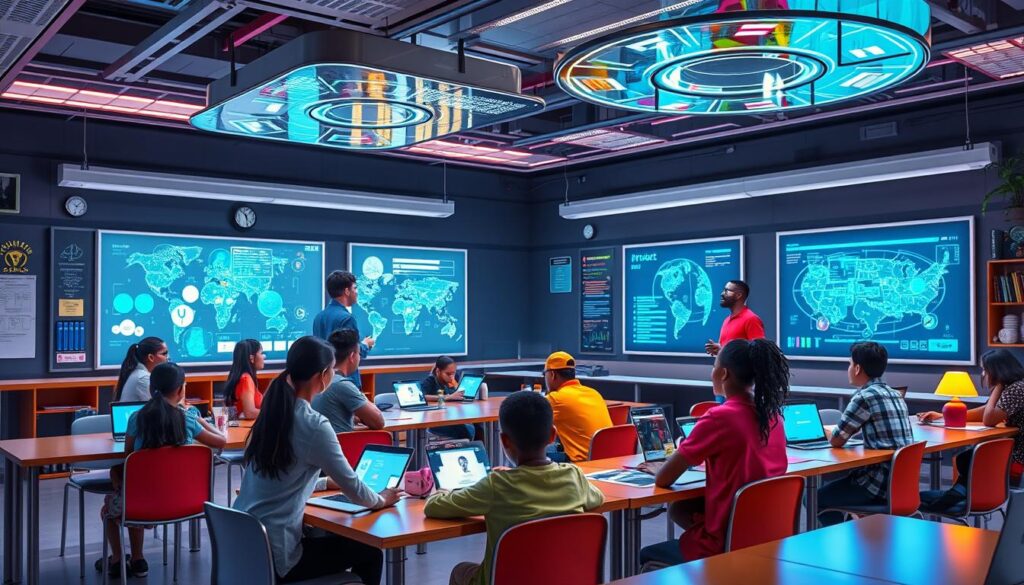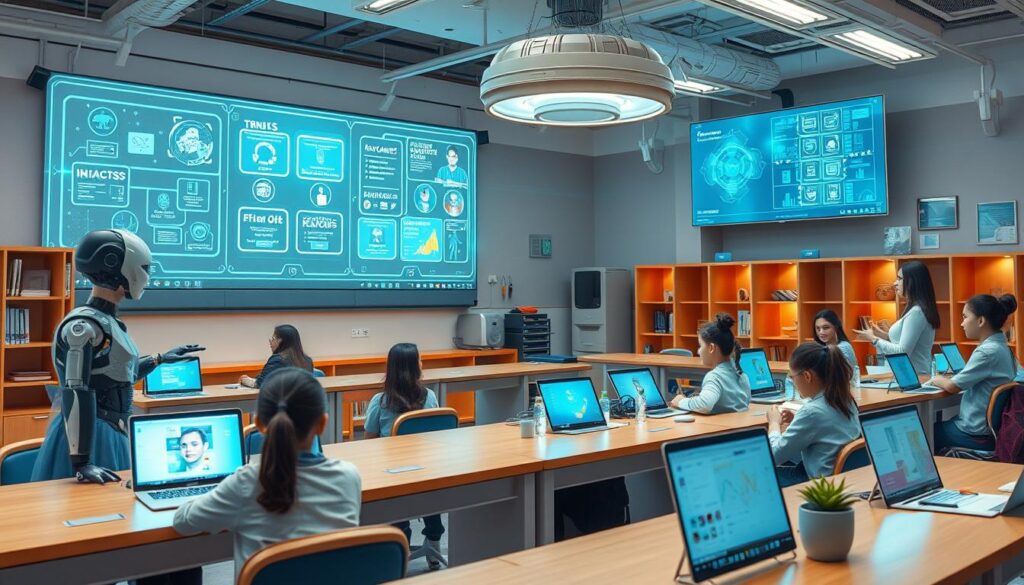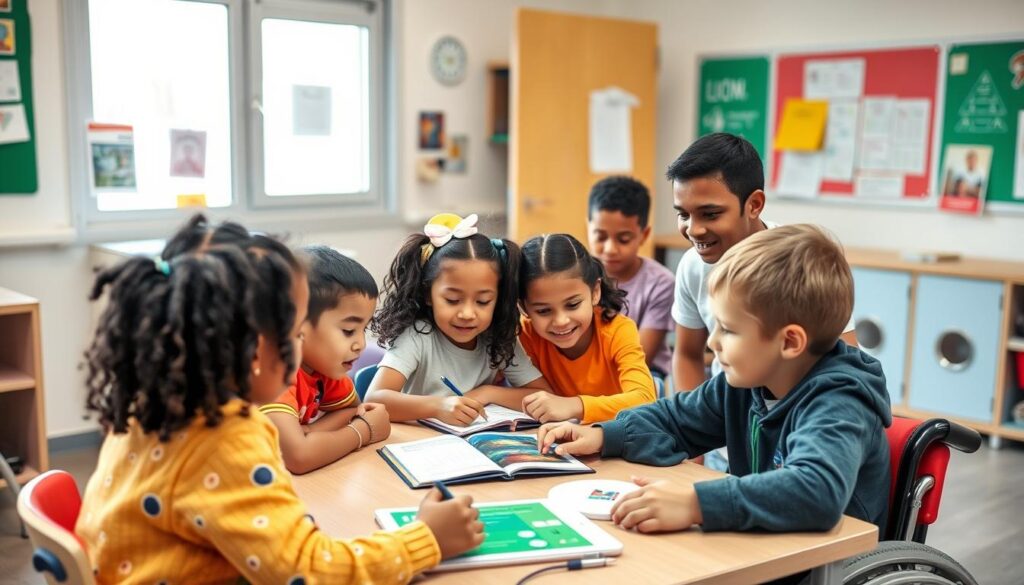Artificial intelligence (AI) is changing education fast. It’s making learning and teaching better in India. Now, education is more personal, adaptive, and uses new tech.
AI brings new chances to education. It offers learning that fits each student’s needs and feedback right away. It’s changing classrooms and helping teachers teach better, so students can do their best.

AI is also making learning fun. With interactive simulations and virtual reality, students get to explore in new ways. This helps them understand hard topics better and get ready for the future.
As AI becomes more part of education, we must think about its ethics. We need to make sure it’s fair, open to everyone, and helps students grow fully. By doing this, India can use AI to make learning better for everyone.
Key Takeaways
- AI is changing education in India, making it more personal and using new tech.
- AI-powered tools, like simulations and virtual reality, make learning exciting and prepare students for the future.
- We must think about AI’s ethics, like fairness and access, to ensure learning is good for everyone.
- AI is making classrooms better, helping teachers and students learn more together.
- AI is helping education become more personal, adaptive, and tech-rich for the future.
Revolutionizing Classroom Dynamics with AI
AI technology is changing education in big ways. It’s making classrooms better for students and teachers. AI helps meet each student’s unique needs and learning style.
Personalized Learning Experiences
AI is making classrooms more personal. It uses smart tutoring and data to create learning plans for each student. AI looks at how well a student is doing and what they need to get better.
It gives students the right content and exercises. This way, every student gets the help they need to do well.
Adaptive Assessments and Feedback
AI has changed how we test students. Now, tests adjust to each student’s level. This means students get feedback that really helps them.
Teachers can use this feedback to improve their teaching. Students get help right away, which helps them learn better.
AI is making classrooms more engaging and effective. It helps students of all levels and backgrounds learn better together.
| Feature | Traditional Learning | AI-Powered Learning |
|---|---|---|
| Personalization | One-size-fits-all approach | Tailored learning experiences |
| Assessments | Standardized, static tests | Adaptive, data-driven assessments |
| Feedback | Delayed, generic feedback | Instant, personalized feedback |
AI in Education: Unleashing New Teaching Methodologies
AI technology is changing how teachers teach. AI-driven teaching methodologies help teachers plan better, grade faster, and give more personal feedback. This makes learning more effective for students.
AI helps with AI-assisted lesson planning. It looks at how students do and what they learn. This way, teachers can make lessons that fit each student’s needs. It makes learning fun and relevant for everyone.
AI-powered grading and feedback systems are also a big help. AI can check work and tests very well. This lets teachers give more personal advice to students. Students get to know their strengths and work on their weaknesses.
AI helps teachers make better choices in the classroom. By using AI insights, teachers can improve their teaching. This makes learning better for everyone.

“AI in education is not about replacing teachers, but about empowering them to be more effective and efficient in their roles.”
Enhancing Accessibility and Inclusion
AI is a big help in making education fair for everyone. It uses AI-powered language translation to break down language barriers. This lets students from different backgrounds fully join in on learning.
This tech makes learning materials available in students’ own languages. It makes education more welcoming and valuable for all.
Assisting Students with Special Needs
AI also makes learning better for students with special needs. It offers tools that adjust lessons and tests to fit each student’s needs. This includes help for those with physical, cognitive, or sensory challenges.
AI is changing how we teach to include everyone. It helps every student do their best. This change is making education fairer and more open for all.

“The future of education lies in AI-powered solutions that unlock the potential of all learners, regardless of their background or abilities.”
AI-Powered Educational Resources
AI is changing how we learn. It brings new tools to the classroom. These tools make learning fun and interactive, changing the way we see education.
Interactive Learning Materials
AI makes learning materials that really grab your attention. They have quizzes, feedback, and games to keep you interested. These tools adjust to how you learn, helping you succeed.
Virtual Reality and Simulations
Virtual reality and AI simulations bring learning to life. Students get to explore real-world scenarios in a safe space. It’s a great way to learn by doing, without the usual classroom limits.
AI is making learning exciting and personal. It helps teachers create lessons that really connect with students. This way, students can achieve great things in their studies.
“AI-powered educational resources have the potential to revolutionize the way we learn, making the educational experience more engaging, adaptive, and tailored to individual needs.”
AI in Education: Ethical Considerations
As AI becomes more common in schools, we must think about its ethics. Issues like data privacy and security and algorithmic bias need careful handling. We need a thoughtful way to use AI in classrooms.
Protecting student data is key. AI systems gather lots of personal info, like grades and behavior. We must have strong data privacy and security to keep students’ rights safe.
Algorithmic bias is another big worry. AI can sometimes show biases, leading to unfair treatment. Teachers must watch for and fix these biases to keep learning fair for everyone.
Creating strong AI governance frameworks is vital. These should include rules made by policymakers, teachers, and tech experts. They help make sure AI is used right in schools, benefiting everyone without harming students.
“The ethical deployment of AI in education is not just a moral imperative, but a crucial step towards realizing the full potential of this transformative technology.”
By tackling the ethical implications of AI in education head-on, we can make the most of this technology. Working together, being open, and sticking to ethical values will help make AI education a positive force.
The Future of Learning: AI-Driven Classrooms
The world is changing fast, and so is education. Artificial Intelligence (AI) is at the heart of this change. AI-driven classrooms are set to change how we learn and get ready for the future.
Preparing Students for the Workforce of Tomorrow
AI is making learning more personal. It helps students get the skills they need for the job market of the future. Teachers can use AI to understand each student better and tailor their learning.
AI also brings real-world learning through simulations and virtual reality. This helps students practice important skills like problem-solving and teamwork. These skills are key for the workforce readiness of tomorrow.
Continuous Learning and Upskilling
The job market is always changing, and we need to keep learning. AI-driven classrooms make continuous learning and lifelong upskilling easier. They help students and professionals stay up-to-date with new skills.
- AI can check your skills and suggest learning paths to fill gaps.
- These classrooms offer easy access to lots of educational resources. This includes interactive content, virtual simulations, and online courses.
AI is changing education for the better. It promises to prepare students for the future of AI in education and the AI-driven classrooms of tomorrow.
Conclusion
The world of education has changed a lot with AI. It brings new ways to learn and teach. AI makes learning personal and helps students get ready for the future.
AI in education opens doors to better learning. It makes learning more accessible and helps students with different needs. This technology is key to a brighter future in education.
By using AI, we can make learning fit each student’s needs. It helps overcome language and special needs barriers. The future of learning is here, and it’s powered by AI.
As we move forward, we must keep learning about AI in education. Stay up to date and work with others to shape the future of classrooms. Together, we can make education better for everyone.
FAQ
What is the role of AI in transforming classroom dynamics?
AI changes classrooms by making learning personal and adaptive. It gives feedback right away. This helps students learn better and meet their own needs.
How can AI-powered teaching methodologies enhance the learning experience?
AI helps teachers plan lessons and grade work. It also gives feedback to students. This lets teachers use data to improve teaching and help students more.
How does AI enhance accessibility and inclusion in education?
AI breaks language barriers, helping all students learn. It also supports students with special needs. This makes learning more inclusive for everyone.
What are the interactive and immersive learning experiences enabled by AI-powered educational resources?
AI makes learning fun and effective with interactive tools. It also uses virtual reality and simulations. These tools give students real-world learning experiences.
What are the ethical considerations surrounding the use of AI in education?
Using AI raises concerns about privacy and bias. It’s important to use AI responsibly. This ensures fair and just learning for all.
How can AI-driven classrooms prepare students for the workforce of tomorrow?
AI classrooms teach students for a tech-driven future. They also support lifelong learning. This helps people keep up with changing job markets.